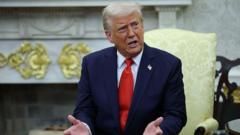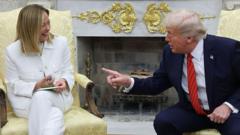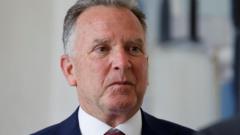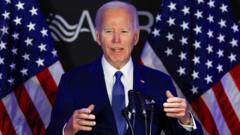In a surprising turn, President Trump announced a 90-day pause on newly implemented global tariffs impacting nearly 60 countries, shortly after their enactment. Despite this move, he raised tariffs on Chinese exports to 125%, escalating tensions between the two economic superpowers. This decision was met with mixed reactions, as U.S. market indices responded positively, reflecting investor relief and optimism amidst ongoing trade uncertainties.
Trump Enacts 90-Day Tariff Pause Amidst Market Turmoil

Trump Enacts 90-Day Tariff Pause Amidst Market Turmoil
President Trump pauses new global tariffs while doubling down on China, prompting a market surge.
On April 9, 2025, President Trump revealed an unexpected shift in his trade strategy by pausing the newly imposed global tariffs that had only just gone into effect. This pause is set for 90 days and applies to almost 60 countries that were facing steep fees. However, Trump maintained his aggressive stance on China, increasing tariffs on all Chinese exports to an astonishing 125%. This response was triggered by China’s retaliatory actions, which had raised their tariffs on American goods to 84%, indicating a fierce trade battle between the two nations.
Trump communicated the tariff pause through a post on his social media platform, Truth Social, stating that these countries would now be subject to a "substantially lowered Reciprocal Tariff" of 10%. As a result, nearly all trading partners will face a blanket tariff of 10%, with the exception of China, which remains under intense scrutiny.
The market's reaction to the announcement was immediate and robust. The S&P 500 surged by approximately 7% within minutes, marking the index’s most significant single-day increase since March of 2020, during the early days of the pandemic. Stocks in various sectors rebounded sharply, with airlines, technology firms, and automakers experiencing notable gains. Despite existing 25% tariffs on imported vehicles, companies like Ford and General Motors saw their shares rise by more than 7%.
When questioned about his sudden reversal on the tariffs so soon after their announcement, Trump appeared to acknowledge the severe market downturn that had resulted in the loss of trillions of dollars in wealth. “Well, I thought that people were jumping a little bit out of line,” he remarked, indicating an awareness of the financial climate and investor sentiment.
The ongoing trade disputes between the U.S. and China remain closely monitored by analysts and investors alike, with the implications of these tariffs continuing to unfold in the global economy.
Trump communicated the tariff pause through a post on his social media platform, Truth Social, stating that these countries would now be subject to a "substantially lowered Reciprocal Tariff" of 10%. As a result, nearly all trading partners will face a blanket tariff of 10%, with the exception of China, which remains under intense scrutiny.
The market's reaction to the announcement was immediate and robust. The S&P 500 surged by approximately 7% within minutes, marking the index’s most significant single-day increase since March of 2020, during the early days of the pandemic. Stocks in various sectors rebounded sharply, with airlines, technology firms, and automakers experiencing notable gains. Despite existing 25% tariffs on imported vehicles, companies like Ford and General Motors saw their shares rise by more than 7%.
When questioned about his sudden reversal on the tariffs so soon after their announcement, Trump appeared to acknowledge the severe market downturn that had resulted in the loss of trillions of dollars in wealth. “Well, I thought that people were jumping a little bit out of line,” he remarked, indicating an awareness of the financial climate and investor sentiment.
The ongoing trade disputes between the U.S. and China remain closely monitored by analysts and investors alike, with the implications of these tariffs continuing to unfold in the global economy.






















